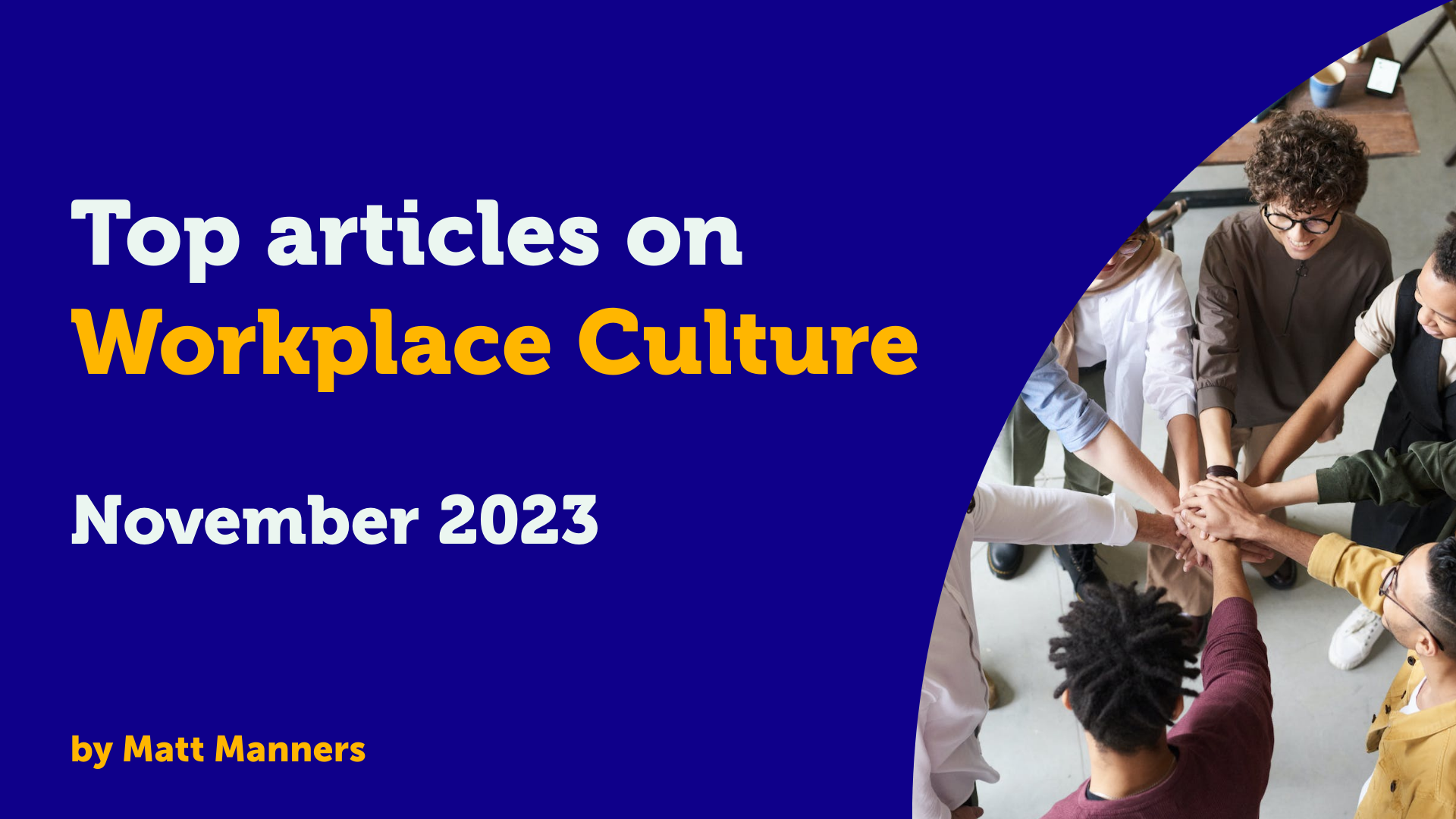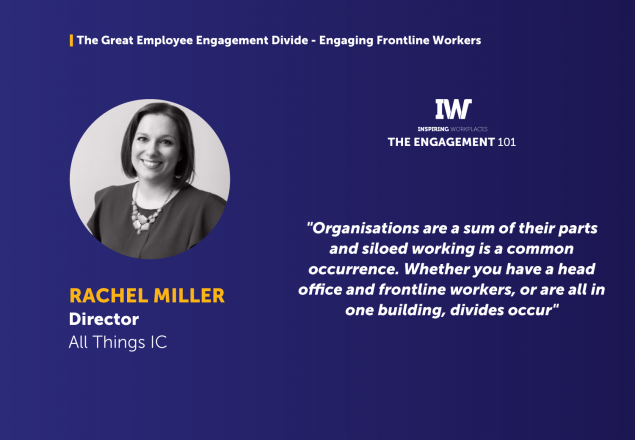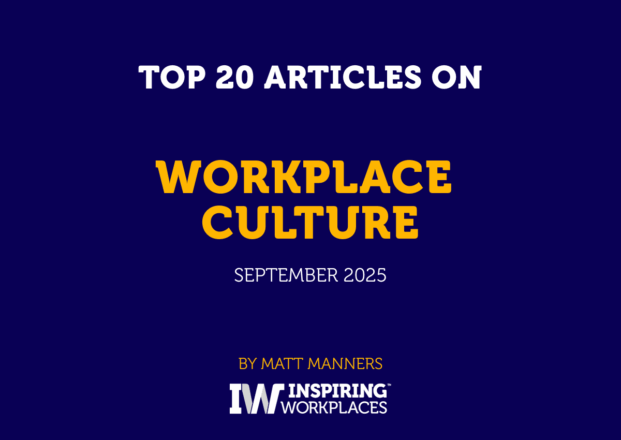
05th December 2023
Top Articles on Workplace Culture in November 2023

Welcome to the Inspiring Workplaces Top Articles on Workplace Culture to help drive organisations forward and improve employee experience.
We want to help inform and inspire you from some of the best content out there. Each month we will consolidate these articles for you to help give you a quick and easy snapshot.
The articles will be underpinned by seven key elements that are reflected in our bespoke COMPASS methodology, that also underpin the Top Inspiring Workplaces worldwide. They are:
- Wellbeing
- Culture & Purpose
- Leadership
- Inclusion
- Employee Experience
- Communication & Voice
- Society & Sustainability
Key Workplace Culture Learnings for November:
- Companies are recognizing the importance of fairness, respect, inclusion, equality, and diversity in the workplace for improving employee engagement and well-being.
- There are disparities in how different racial backgrounds perceive inclusivity at work, highlighting the need for greater inclusivity efforts.
- Psychological safety is crucial for trust and innovation in the workforce, and it involves commitment, communication, and practical tools.
- The 2024 Employee Experience Trends Report reveals rising employee expectations, particularly among new hires, and the importance of career growth and hybrid work arrangements.
- There is a significant gap between C-suite leaders’ perceptions of worker well-being and the realities workers experience, highlighting the need for improved well-being initiatives.
- Effective workplace communication is essential for a thriving work environment, fostering openness, confidence, trust, and clarity.
- Boards and senior management teams are increasingly focusing on employee well-being and its impact on performance.
- Investing in inclusion initiatives pays off, leading to increased feelings of inclusion and higher recommendations of employers.
- Creating quality jobs through shared ownership in the workplace can positively impact employee well-being, engagement, and retention.
- Successfully integrating corporate purpose into an organization requires leaders at all levels to embody, communicate, and align with the company’s purpose, as well as recognizing and rewarding purpose-driven behaviors.
These learnings were extracted from insightful articles summarized below…
New Data Explores Inclusion and Belonging in UK Workplaces
Source: HR Magazine
Author: Carolyn Nevitte
IW COMPASS point: Inclusion
In the quest to improve employee engagement and well-being, businesses are recognizing the importance of fairness, respect, inclusion, equality, and diversity in the workplace. Research reveals disparities between how white employees and those from Asian and black backgrounds perceive inclusivity in their workplaces. There’s a notable gap in feelings of belonging, comfort in speaking up, and trust in addressing inappropriate behavior. While progress has been made, there’s still work to be done to create a more inclusive and accepting environment where all employees can thrive, voice their opinions, and be themselves.
Key Takeaways
- A sense of belonging is crucial for employee satisfaction, engagement, and retention.
The American Psychological Association’s 2023 Work in America Survey highlights the importance of connection and community in the workplace. - Belonging is identified as a fundamental need, and it is a more powerful driver of employee well-being than strategy or culture.
- Inclusion, equity, and diversity are related to belonging but not the same; they are part of the actions employers take to foster belonging.
- Many employees, including customer service workers, Black Americans, Hispanic Americans, front-line workers, office workers, and manual laborers, report feeling isolated or lonely at work.
- Belonging is not confined to physical workplace buildings; it involves daily behaviors that convey care, support, and a sense of importance.
- The “moveable middle” in organizations often goes unrecognized and disconnected, contributing to tension and dissatisfaction.
- Leaders and HR professionals play a crucial role in fostering belonging by engaging, communicating, and empowering employees.
- Belonging manifests in various ways in the workplace, including encouraging individual perspectives, authenticity, meaningful relationships, and trust.
- The pandemic has complicated the sense of belonging, with in-person, hybrid, and remote work arrangements.
- To promote belonging, leaders should have open office hours, provide well-being programs, encourage collaboration, and engage in one-on-one conversations with employees.
Read the full article here
How (And Why) I Created A Culture Of Trust
Source: Chief Executive
Author: Stan Moss
IW COMPASS point: Culture & Purpose, Leadership
Psychological safety in the workforce is essential for trust and innovation. Building a culture of trust involves commitment, communication, and practical tools. Polen Capital implemented a trust-focused initiative, assigning trust pillars, reading materials, and training to foster trust and openness. Relationships and storytelling are key to building trust, supported by technology and in-person interactions. Radical candor, giving and receiving feedback, relies on trust and vulnerability. Leading by example, demonstrating openness, and modeling desired behaviors are crucial for creating and maintaining psychological safety in the workplace.
Key Takeaways
- Trust is the foundation of psychological safety, and around 25% of employees lack trust in their employers.
- To create a culture of trust and psychological safety, commit to it and communicate it clearly and consistently across the organization.
- Provide practical tools, strategies, and frameworks for employees to uphold a trustful, psychologically safe culture.
- Building relationships and giving a voice to team members through storytelling and in-person interactions are essential for trust-building.
- Embrace radical candor, which involves giving and receiving real-time, constructive feedback, but remember that it requires a high degree of trust.
- Lead by example and model the behaviors you expect from others, including being a good receiver of feedback.
- Continuous effort and improvement are necessary for maintaining psychological safety and fostering a culture of trust, openness, and empowerment.
Read the full article here
Employee Expectations on the Rise
Source: HR Today
Author: Maggie Mancini /Research by Qualtrics
IW COMPASS point: Employee Experience
The 2024 Employee Experience Trends Report from Qualtrics highlights rising employee expectations, with new hires showing lower engagement and well-being compared to tenured employees. About 39% of employees with less than six months at a company plan to leave within the next year, a six-point increase from the previous year. Career growth is a key driver of engagement, but new hires are less likely to believe their career goals can be met. Hybrid work arrangements lead to higher engagement, intent to stay, and well-being. Organizations must focus on flexibility, improve communication, and build trust when incorporating AI into the workplace.
Key Takeaways
- Employee expectations in 2024 will be high, and employees want a voice in shaping their workplace experience.
- New hires show lower levels of engagement and well-being compared to tenured employees, with 39% planning to leave within their first year.
- HR should prioritize onboarding as first impressions are crucial for employee retention.
- Career growth is a significant driver of engagement, and HR should focus on helping new hires believe in their career goals.
- Employees with hybrid work schedules have the highest levels of engagement, intent to stay, and well-being.
- Workplace flexibility should consider not only where but also when and how work is done.
- Employees are comfortable with passive listening to work-related communications but less comfortable with the use of social media for feedback.
- Trust can be improved through better listening and communication strategies, such as the three-by-three approach.
- AI adoption in the workplace should start gradually with lower-stakes scenarios to build employee comfort and trust.
- Human accountability should be emphasized alongside AI integration to maintain trust among employees.
Read the full article here
Six Leader/Worker Disconnects Affecting Workplace Well-being
Source: Deloitte Insights
Authors: Jen Fisher, Dr. Jay Bhatt, Amy Fields
IW COMPASS point: Wellbeing
The Deloitte 2023 Well-being at Work survey highlights a significant gap between C-suite leaders’ perceptions of worker well-being and the realities workers are experiencing. Employees are struggling to make progress in improving their well-being, despite a high level of motivation. There’s also a disconnect in how employees view organizational leadership’s concern for their well-being. To bridge these gaps, leaders are urged to measure and report well-being metrics, tie bonuses to human sustainability goals, increase transparency, empower managers, adopt a long-term approach, and appoint a leader responsible for advancing human sustainability. Closing these gaps is vital for improving employee well-being.
Key Takeaways
- Workplace well-being is a top priority for both employees and C-suite leaders, with 84% of respondents considering it more important than advancing their careers.
- Organizations are shifting towards a holistic approach to human sustainability, focusing on creating value for workers and society as a whole.
- Despite good intentions, many well-being initiatives lack clear measurements and accountability, leading to worsened employee well-being in various dimensions.
- There are six significant disconnects between C-suite leaders’ perceptions of worker well-being and the realities workers are experiencing, contributing to the well-being paradox.
- To address these gaps, leaders should measure and publicly report well-being metrics, make leaders more accountable for human sustainability goals, increase transparency, empower managers, adopt a broader approach, and appoint a leader responsible for advancing human sustainability.
- Failure to bridge these gaps may lead to disengagement and attrition among top talent, affecting workplace well-being.
Read the full article here
Return-to-Office Plans Don’t Have to Undermine Employee Autonomy
Source: Harvard Business Review (HBR)
Authors: Kimberly Shells and Caitlin Duffy
IW COMPASS point: Employee Experience
The evolving corporate landscape is placing greater emphasis on serving all stakeholders, not just shareholders. Renewed corporate purpose statements focus on human-centric values like employee well-being. However, the shift towards return-to-office mandates in the hybrid work era can threaten employee autonomy and well-being. To navigate this, organizations must prioritize employee autonomy, facilitate interpersonal connections, and foster inclusive onsite environments. This approach ensures a balance between flexibility and connection while aligning with a human-centric corporate purpose, ultimately benefiting both the business and stakeholders. Open dialogue with employees remains crucial in adapting to changing work models.
Key Takeaways
- Corporations are shifting from a focus solely on shareholders to serving all stakeholders, including employees.
- Corporate purpose statements have become more human-centric, emphasizing employee well-being and inclusion.
- Return-to-office mandates, if not implemented strategically and transparently, can undermine employee flexibility and autonomy.
- Autonomy is crucial for employee well-being and retention, and policies should provide guidelines rather than strict requirements.
- Organizations should invest in employees’ personal and professional growth and facilitate connections for both younger and older employees.
- Building connections should focus on meaningful team days and regular offsites to foster social connections and networking.
- Diversity, equity, and inclusion (DEI) remains a central concern, with many organizations still working on building inclusive cultures.
- Hybrid work introduces complexities for DEI, and leaders should be mindful of biases toward onsite workers.
- Inclusion is higher among remote workers who have more privacy and control over their workspace.
- Building an inclusive culture in a hybrid world requires open communication, equipping managers, and embedding inclusion into employees’ everyday work.
- Return-to-office mandates should align with a human-centric corporate purpose to maintain trust, connection, and employee well-being.
Read the full article here
Beyond Words: The Benefits of Healthy Communication at Work
Source: The HR Director
Author: Surya Varma Mehta
IW COMPASS point: Communication
Effective workplace communication is crucial for a thriving work environment, promoting smooth interactions between employees at all levels. Companies should guide employees on respectful and efficient communication, utilizing mental health platforms to align the workforce. Healthy communication also has significant benefits for employees’ mental health, fostering openness, confidence, trust, and clarity. Two-way communication enhances collaboration and understanding, vital for achieving shared goals. The rise of remote and hybrid work necessitates effective communication via internal channels and remote meetings, emphasizing the importance of training and mental health support. Healthy communication enhances team cohesion, boosts confidence, ensures clarity and trust, minimizes conflicts, and promotes mental well-being, ultimately creating a positive workplace culture.
Key Takeaways
- Effective communication at work involves understanding and actively interpreting the underlying meaning and emotions in messages, fostering empathy, trust, and unity.
- Two-way communication is crucial for clarity, problem-solving, and building stronger relationships among employees.
- Remote and hybrid work settings require open lines of communication, continuous feedback, and up-to-date communication tools to ensure employees feel comfortable and confident.
- Healthy communication at work offers several benefits, including improved team cohesion, boosted employee confidence and self-esteem, an environment of clarity and trust, fewer conflicts, and enhanced mental well-being.
- Nurturing healthy communication in the workplace is essential for fostering a positive space for mental health and organizational success.
Read the full article here
Why Boards And C-Suites Care About Employee Wellbeing
Source: Forbes
Author: John M. Bremen
IW COMPASS point: Wellbeing
Boards and senior management teams are increasingly focusing on employee wellbeing and its impact on performance as intangible assets become a larger part of corporate valuations. Healthy, engaged, and financially secure employees are more effective, make better decisions, and drive superior results. Effective leaders care about physical and mental health, access to healthcare, living wages, job satisfaction, advancement opportunities, physical safety, respect, and fair pay. They understand the connection between wellbeing and performance, articulate the materiality of human capital and wellbeing, practice “CARE governance,” and measure four dimensions of employee wellbeing: physical, emotional, financial, and social.
Key Takeaways
- Effective leaders understand that employee wellbeing is linked to performance, and they are concerned about various aspects of employee wellbeing, including physical and mental health, financial security, engagement, job satisfaction, safety, respect, and fair pay.
- Leaders take actions related to wellbeing, corporate governance, and performance, including measuring and reviewing wellbeing and performance data for their organizations.
- They articulate the materiality of human capital and wellbeing, recognizing their impact on various financial and operational dimensions, such as supply chain, productivity, reputation, ESG adherence, and value creation/erosion.
- Effective boards and senior management teams practice “”CARE governance,”” focusing on four components: compensation and benefits, advancement, retirement, and experience, to ensure essential topics related to wellbeing are covered and discussed.
- Employee wellbeing is measured across four key dimensions: Physical, Emotional, Financial, and Social. Measurement includes factors like health care coverage, absenteeism, emotional health, financial resilience, and social connection.
Read the full article here
The Business of Belonging
Source: Bain & Company
Authors: Julie Coffman, Alex Noether, Bianca Bax, Cassy Reichert, and Krystle Jiang
IW COMPASS point: Inclusion & Belonging
Investing in inclusion pays off, according to a survey of more than 6,000 employees in four countries. Those who saw their firms making such investments since 2020 were three times as likely to feel fully included as colleagues at businesses without such initiatives. Inclusion scores among underrepresented groups – including Black, Asian and LGBTQ staff – have increased by 7% on average between 2021 and 2023, while employees who reported feeling included were up to 12 times more likely to recommend their employers. However, no more than 35% of any demographic group said they felt fully included.
Key Takeaways
- Companies that intentionally invest in inclusion have seen positive results. Employees who have witnessed their employers making intentional inclusion investments since 2020 are three times more likely to feel fully included compared to those who haven’t seen such investments.
- Inclusion scores have risen for historically underrepresented groups, including Black, Latino, Asian, and LGBTQ employees, with an average increase of seven percentage points between 2021 and 2023.
- Inclusion and belonging are essential for an organization’s talent and business strategies as they unlock employees’ highest potential, leading to increased creativity, problem-solving, and innovation.
- While diversity and inclusion are related, they have separate impacts on team performance. Diverse teams generate more innovative ideas, but inclusion is necessary to fully harness the potential of diversity.
- Inclusion is crucial for job seekers, with approximately 50% considering it very important in a prospective employer. Employees who feel fully included are more likely to promote their companies and stay with their organizations.
- Employers need to focus on universal enablers of inclusion, such as clear career pathways and investment in professional growth through mentorship and sponsorship programs.
- A strategic approach to inclusion involves creating an inspiring vision of how inclusion benefits the business and engaging and enabling the organization to act on that vision.
- Encouraging individuals to adopt “”micro-missions”” can help them practice inclusion in their daily routines.
- Investing differentially in leaders who promote inclusion is essential, as leaders have a significant impact on employee sentiments and behaviors.
- Creating a more inclusive organization is a journey that requires ongoing efforts, adaptability, and a commitment to change.
Read the full article here
Building Quality Jobs Through Ownership
Source: Gallup
Author: Areen Jalajel
IW COMPASS point: Employee Voice
The article highlights the importance of creating quality jobs through shared ownership in the workplace. It discusses how low trust and poor incentive alignment between employees and leaders can negatively impact employee wellbeing, engagement, and retention. The article emphasizes the need for leaders to build a culture of ownership where employees have a voice, rights, and responsibilities in the company. When employees feel like true owners, they become more motivated to contribute to the company’s success, resulting in better performance, engagement, and loyalty. The article also mentions the partnership between Gallup and Ownership Works to measure employee engagement and promote a culture of ownership. Ultimately, shared ownership is seen as a win-win scenario that benefits both companies and employees.
Key Takeaways
- A significant portion of the workforce is not thriving at work, with only 23% of people reporting high levels of engagement.
- Poor mental health due to work-related stress negatively impacts employee performance, engagement, and loyalty.
- Peter Stavros founded Ownership Works to address the problem of low trust and poor incentive alignment between employees and leaders.
- A culture of ownership involves both rights and responsibilities for employees and the company, promoting engagement and motivation.
- Employees in quality jobs are more engaged, enthusiastic, and committed to their work and workplace, resulting in improved performance.
- Employee engagement is highly predictive of positive business, employee, and customer outcomes.
- Engaged employees are less likely to seek other job opportunities and are more likely to recommend their workplace.
- Employee ownership and engagement together lead to strong employee retention, with 97% of engaged, ownership-driven employees planning to stay with their company.
- The Gallup Q12 survey is a valuable tool for measuring and improving employee engagement and ownership.
- Manager development is essential, as managers play a significant role in driving team engagement levels.
- Ownership Works is a nonprofit organization partnering with companies to increase shared ownership at work, improving employee well-being and financial returns.
- A culture of ownership contributes to a more inclusive and equitable economy, benefiting both companies and employees.
Read the full article here
How Leaders Can Create a Purpose-Driven Culture
Source: Harvard Business Review (HBR)
Authors: Rodolphe Durand and Ioannis Ioannou
IW COMPASS point: Leadership, Culture & Purpose
Companies increasingly prioritize corporate purpose, but integrating it successfully hinges on organizational culture. A purpose-driven culture requires leaders at all levels to embody and communicate the company’s purpose and values. Purpose should be aligned with strategy and operations, with transparency about short-term sacrifices. Employees must understand how their roles contribute to the purpose and be given some autonomy in aligning their choices with it. Recognizing and rewarding purpose-driven behaviors, showcasing real sacrifices for purpose, and integrating purpose into incentive schemes also play vital roles in embedding a purpose-driven culture.
Key Takeaways
- Corporate purpose goes beyond profitability and involves ethical behavior and broad responsibility.
- Organizational culture plays a pivotal role in successfully integrating purpose into business strategy.
- Three strategies are crucial for integrating purpose:
- All leaders at all levels should embody purpose by connecting it to performance and acknowledging short-term trade-offs.
- Making purpose tangible for team members involves translating it into day-to-day functions, incorporating team members’ perspectives, and balancing autonomy with decision-making guidelines.
- Anchoring purpose through recognition and incentives showcases sacrifices for purpose, celebrates purpose-driven impact, and integrates purpose metrics into reward programs.
- Authentic and well-defined corporate purpose can lead to enhanced market positioning, stakeholder trust, collaboration, and strategic resilience, contributing to sustained profitability and tangible societal and environmental benefits.
Read the full article here.





